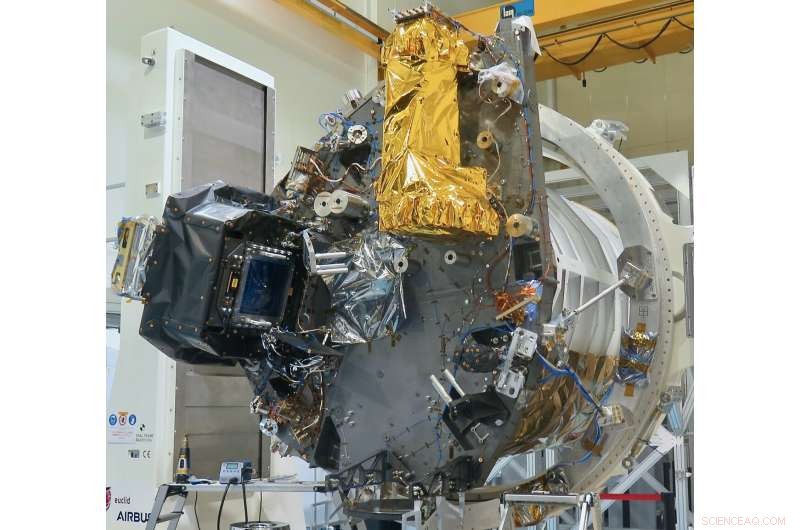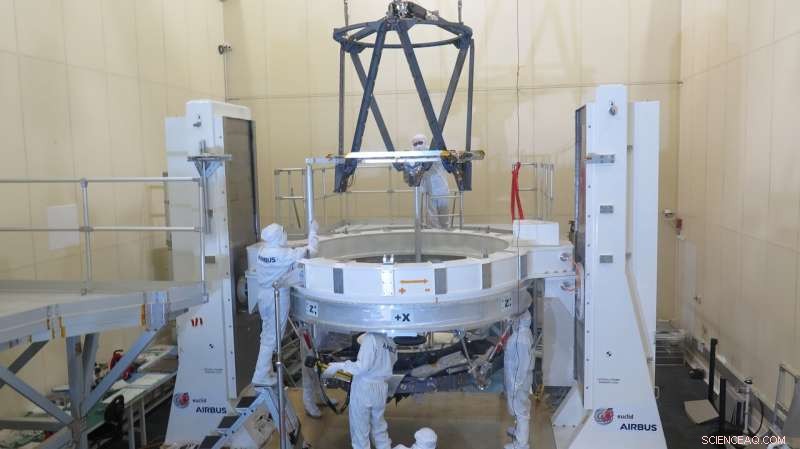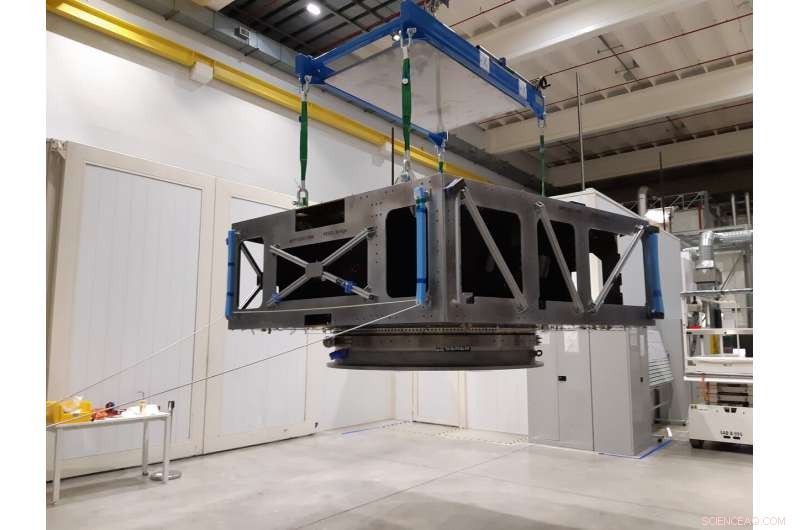
VIS- och NISP-instrumenten på Euclids nyttolastmodul. Kredit:Airbus
ESA:s Euclid-uppdrag har nått ytterligare en milstolpe på sin resa mot uppskjutning. Dess två instrument är nu byggda och helt testade. Dessa har levererats till Airbus Defence and Space i Toulouse, Frankrike, där de nu integreras med teleskopet för att bilda uppdragets nyttolastmodul.
Euclid består av ett spegelteleskop på 1,2 meter som är designat för att fungera vid både synliga och nära-infraröda våglängder – den senare är bara längre än vad det röda ljuset människor kan se. Teleskopet kommer att samla in ljus från avlägsna kosmiska objekt och mata in det i två instrument.
Det synliga instrumentet (VIS) och den nära infraröda spektrometern och fotometern (NISP) kommer att köras parallellt, registrerar data samtidigt från vilken del av himlen som teleskopet pekar mot.
Euklids uppdrag är att mäta formerna på mer än en miljard galaxer, och de exakta rödförskjutningarna av tiotals miljoner galaxer över mer än en tredjedel av himlen. Rödförskjutningen är en effekt som orsakas av universums expansion. Det sträcker ut våglängden av ljus som sänds ut av avlägsna galaxer; ju längre bort galaxen, desto mer extrem är rödförskjutningen. Galaxerna i Euklids undersökning kommer att sträcka sig över 10 miljarder år av kosmisk historia, och tillåta forskare att undersöka den mystiska mörka materien och mörka energin som tros dominera universum.
VIS-instrumentet kommer att hantera den exakta mätningen av galaxformer genom att ta de allra bästa bilderna av avlägsna galaxer som det möjligen kan. Att göra detta, instrumentet använder en mosaik av 36 CCD, var och en innehåller 4000 pixlar gånger 4000 pixlar. Detta ger detektorn totalt cirka 600 megapixlar.
"Designen, utveckling, tillverkning, testning och kalibrering av VIS-instrumentet under ett dussin år till en strikt specifikation har varit en utmaning, " säger Mark Cropper, VIS-instrumentledare och professor vid UCL Mullard Space Science Laboratory, STORBRITANNIEN.
"Vi är oerhört stolta över vad VIS-teamet har uppnått för att föra detta projekt till sin kulmen. Att det slutliga resultatet överträffar våra förväntningar är en hyllning till deras expertis, engagemang och professionalism."
Inte bara är antalet pixlar imponerande, instrumentet kommer också att leverera den bästa känsligheten i svagt ljus över ett brett spektrum av våglängder vid långa integrationstider.
"Det här är väldigt speciella CCD, de har utvecklats speciellt för Euklid under många år, säger Alex Short, ESA:s VIS-nyttolastingenjör.
Det andra instrumentet, NISP, är tillägnad att göra spektroskopiska mätningar av galaxer, vilket innebär att de delar upp sitt ljus i individuella våglängder. Detta gör att rödförskjutningarna kan härledas. Denna egenskap tillåter kosmologer att uppskatta avståndet till galaxen i fråga, och kommer att tillåta Euklids data att omvandlas till den största, mest exakta 3D-undersökning av universum som någonsin genomförts.
"Det internationella NISP-teamet och stödjande industrier gjorde ett otroligt jobb med att designa, utveckla och testa detta utmanande instrument, säger Thierry Maciaszek, NISP instrument projektledare, från CNES och Laboratoire d'Astrophysique de Marseille, Frankrike.
"Detta är, dock, inte slutet på historien för oss eftersom många stora aktiviteter måste slutföras med NISP på satellitnivå. Vi väntar otåligt på det första ljuset under flygningen som visar de utmärkta globala prestationerna."
NISP-detektorn kommer att ha det största synfältet som någonsin flugits i rymden för ett infrarött instrument.
"Kvaliteten på optiken är bara fantastisk, säger Tobias Boenke, Mission System &NISP Instrument Engineer på ESA.
En nyckelfaktor för att uppnå Euclids exceptionella optiska noggrannhet var ett beslut som togs tidigt i projektets historia att konstruera hela nyttolastmodulen av kiselkarbid. Användningen av detta material vid ESA var banbrytande i tillverkningen av teleskopet för Herschel-rymduppdraget. På ESA:s Gaia-uppdrag, stödstrukturen för rymdfarkostens delsystem var monterade på en ram av kiselkarbid. På Euklid, materialet har använts för såväl instrumenten som teleskopet.
Medan metall expanderar och drar ihop sig när temperaturen ändras, vilket försämrar ett optiskt systems förmåga att fokusera ljus, kiselkarbid är extremt stabil mot sådana temperaturvariationer. Men att använda föreningen ger sina egna utmaningar. Kiselkarbid är en keramik och så mycket mer spröd än metall.

The supporting structure of the telescope’s secondary mirror for ESA’s Euclid spacecraft being brought together for final integration and optical alignment at Airbus in Toulouse, Frankrike. Kredit:Airbus
"It was a big challenge to be able to manufacture the instruments from this material and make sure they can remain undamaged during the launch, " adds Tobias.
Like VIS, NISP also uses specially designed state-of-the-art detectors to record the faint light coming from distant stars and galaxies. Unlike VIS, NISP can also operate in spectrographic mode. Detektorerna, which are operated at –180°C to provide ultra-low noise and high sensitivity, register these 'spectra' and convert them into tiny electronic signals. These signals can then be amplified and accurately measured to provide the photometric and spectroscopic redshifts.
The instruments will receive light from Euclid's telescope, which has already been assembled at Airbus, Toulouse. Like the instruments, it too is made from silicon carbide and is a state-of-the art construction in all senses.
"We are pushing all the manufacturing levels to the limit, " says Luis Miguel Gaspar Venancio, ESA's Mission Performance &Optical Systems Engineer.
A special component behind the telescope, called the dichroic, separates the collected light and diverts the visible wavelengths to VIS and the infrared wavelengths to NISP.
When the information from VIS and NISP is combined, scientists will be able to deduce the way that the Universe's large-scale distribution of galactic structures has built up throughout cosmic history. This will help them determine the speed at which such structures grow, providing strong constraints on the nature and amount of dark matter and dark energy in the Universe.
The instruments were prepared for delivery to Airbus just before the COVID-19 pandemic imposed restrictions and lockdowns in many ESA member states. Lyckligtvis, VIS was already at Airbus, and NISP had to wait for a few weeks for shipment from Marseille to Toulouse, but was not on the critical path.
"I am extremely grateful to all project parties:institutes, industry and colleagues at ESA for their dedication and commitment during these difficult times, " says Giuseppe Racca, ESA's Euclid project manager.

The flight model of ESA’s Euclid mission’s service module being moved in the clean room at Thales Alenia Space in Torino, Italien. Credit:Thales Alenia Space Italy
"We were hit by the pandemic in a particularly critical moment when both VIS and NISP were to be transferred to industry. Despite the work and travel restrictions a concerted effort by all parties allowed to minimize the delays by implementing distributed and sequential integration activities of the instrument units and remote monitoring."
Now that the instruments have been delivered to Airbus, they will be integrated first with the telescope, and next with the rest of the payload module. It has been a long journey getting this far. Euclid was selected for implementation in 2011, having already undergone almost five years of studies. While there is still a lot of hard work and testing ahead, the delivery of the instruments and telescope means that the spacecraft can really begin to come together.
"Till sist, we have something in front of our eyes, " says Luis Miguel. "It's not just paper anymore. It's a fantastic piece of hardware; beautiful in a way."
Integrating the payload module will last several months as it is painstaking work to get everything bolted together, precisely aligned and electronically talking. The instrument's control units have already been mechanically and electrically integrated to the payload module. These tests have verified that the instruments can be properly powered by the spacecraft, can talk to the onboard computers, and can transmit the science data that will then be downloaded to ground through the spacecraft antennas.
Once the telescope has been integrated with the rest of the payload module, it will be shipped to Centre Spatial de Liège, Belgien, for 'end-to-end' testing in a thermal vacuum chamber that can simulate the conditions of space as well as possible on Earth. This test is scheduled to take place in February and March 2021.
Once that test shows that everything is working as expected, the payload module will be shipped to the prime contractor Thales Alenia Space (TAS), in Torino, Italien. TAS has been building the service module, which contains essential systems such as power, propulsion and communications.
The service module's main structure recently passed its structural and thermal tests and is now ready to have the various systems integrated inside. TAS will begin by laying down the pipelines for the propulsion systems, and the cabling for other distributed systems. Flight electronics, inklusive datorer, power units, and attitude control units, are already mounted on their own structural panels and these will now be installed inside the main structure. Integration is due to be complete in the third quarter of the year, at which time tests will be performed.
TAS will then integrate the payload module with the service module to form the final, finished spacecraft. Sedan, another round of tests will ensure that everything is working together properly. Vid det tillfället, the spacecraft is essentially finished, and ready for launch.
Launch is currently scheduled for the second half of 2022 from Europe's spaceport, Kourou, Franska Guyana.